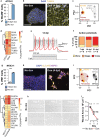A comprehensive library of human transcription factors for cell fate engineering
- PMID: 33257861
- PMCID: PMC7610615
- DOI: 10.1038/s41587-020-0742-6
A comprehensive library of human transcription factors for cell fate engineering
Abstract
Human pluripotent stem cells (hPSCs) offer an unprecedented opportunity to model diverse cell types and tissues. To enable systematic exploration of the programming landscape mediated by transcription factors (TFs), we present the Human TFome, a comprehensive library containing 1,564 TF genes and 1,732 TF splice isoforms. By screening the library in three hPSC lines, we discovered 290 TFs, including 241 that were previously unreported, that induce differentiation in 4 days without alteration of external soluble or biomechanical cues. We used four of the hits to program hPSCs into neurons, fibroblasts, oligodendrocytes and vascular endothelial-like cells that have molecular and functional similarity to primary cells. Our cell-autonomous approach enabled parallel programming of hPSCs into multiple cell types simultaneously. We also demonstrated orthogonal programming by including oligodendrocyte-inducible hPSCs with unmodified hPSCs to generate cerebral organoids, which expedited in situ myelination. Large-scale combinatorial screening of the Human TFome will complement other strategies for cell engineering based on developmental biology and computational systems biology.
Conflict of interest statement
A.H.M.N., P.K., V.B., and G.M.C. are inventors on patents filed by the Presidents and Fellows of Harvard College. Full disclosure of G.M.C. is available on
Figures





References
-
- Davis RL, Weintraub H, Lassar AB. Expression of a single transfected cDNA converts fibroblasts to myoblasts. Cell. 1987;51:987–1000. - PubMed
-
- Takahashi K, Yamanaka S. Induction of pluripotent stem cells from mouse embryonic and adult fibroblast cultures by defined factors. Cell. 2006;126:663–676. - PubMed
Publication types
MeSH terms
Substances
Grants and funding
LinkOut - more resources
Full Text Sources
Other Literature Sources
Molecular Biology Databases
Research Materials
Miscellaneous

